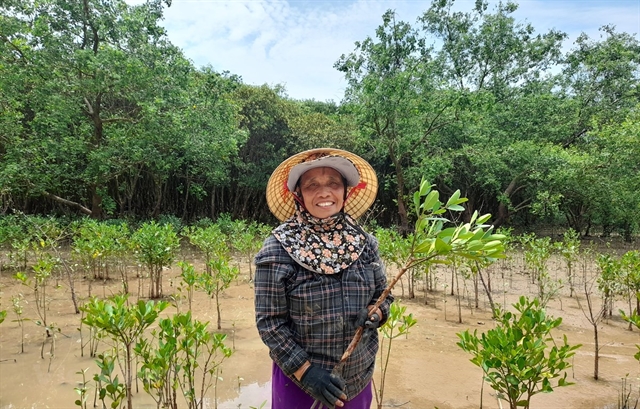 Environment
Environment

To people living in the coastal areas, mangroves serve as the ‘green walls’ that protect them from storms and typhoons.
 |
| Bùi Thị Dìn, a resident of the coastal Đa Lộc Village in Thanh Hóa Province, has helped grow the local mangrove forest for the past 15 years. — VNA/VNS Photo |
THANH HÓA — It is impossible for Bùi Thị Dìn to recount the exact number of trees she has planted in the mangroves in Thanh Hóa Province over the past 15 years.
The resident of Đa Lộc Village said the figure could be in the thousands.
“Ever since this strip of mangrove has grown, we are much more assured every time a storm comes,” said Dìn, who was also the head of her village’s women’s union.
When she first joined others to grow the mangrove, large waves and a huge amount of trash washing ashore were critical issues impacting the trees’ growth.
The number of trees reaching maturity was also very limited.
These problems were later mitigated thanks to the community’s efforts in cleaning up the coast.
Cultivation training was also offered to the locals as part of the project ‘Improving the resilience of vulnerable coastal communities to climate change-related impacts’ - a governmental initiative financed by the Green Climate Fund (GCF) through the United Nations Development Programme (UNDP).
Gesturing at a one-year-old area of mangrove, Bùi Quyết Chiến, a resident in the same village, could not help but express his joy at this ‘green wall’.
Chiến said: “Thanks to this mangrove, our village is no longer worried about storms.
“The mangrove not only protects people of my Đa Lộc Village, but also others such as Hưng Lộc, Ngư Lộc, and Minh Lộc, as it forms the most crucial barrier.”
Lê Đức Giang, Vice Chairman of Thanh Hóa People’s Committee also said that the locality has been one of the most affected by natural disasters.
However, since 2017, when the climate change impact mitigation project was deployed in the area, Thanh Hóa Province has revived and cultivated more than 337ha of mangrove as protection against harsh weather conditions.
Giang said: “The mangrove significantly averts the impact of large waves and storms.
“Typhoons of level 7 or 8, when blocked by the mangrove, could be reduced to level 4 or 5, and therefore protect the people.”
Visiting the flourishing mangrove along Thanh Hóa coast, UNDP Resident Representative in Việt Nam Caitlin Wiesen said that these forests are important buffer zones for marine ecology and coastal communities.
After five years of implementation, the UN-backed project has revived 4,000ha of mangrove in vulnerable coastal areas in the provinces of Quảng Ngãi, Thanh Hóa, Quảng Nam, Cà Mau, and Nam Định.
From an expert’s perspective, Lê Anh Tuấn, deputy director of Cần Thơ University’s Research Institute for Climate Change agreed that the mangrove is a life-saving model.
Not only ensuring livelihoods for locals, it also plays an important role in adapting to climate change.
Tuấn gives high praise to the model of reviving and growing mangroves in coastal areas, and recommends that it be scaled up across the country.
Lê Đức Giang added that the current 337ha of mangrove in Thanh Hóa Province is only the beginning.
The next step is to take care of these forests, which require funding and personnel in order to maintain their protective ability.
Local authorities also asked the Government and UNDP for assistance in terms of livelihood models, in order to increase responsibility and proactiveness in protecting the mangroves. — VNS
BOX
According to statistics from Việt Nam Administration of Forestry, as of 2019, the total area of forest and coastal forestry land nationwide is 709,013ha, spanning 28 coastal cities and provinces.
While coastal forests only take up approximately three per cent of the national forest area (with mangroves accounting for around one per cent), they play a critical role in maintaining ecological balance and biodiversity, preventing erosion, and protecting sea dykes and people’s livelihoods.
Following the Prime Minister’s Decision No 120/QĐ-TTg on the protection and development of coastal forests in adapting to climate change in the 2015 - 2020 period, the country has worked to preserve 295,164ha of coastal forest and grow 22,390 new hectares.




